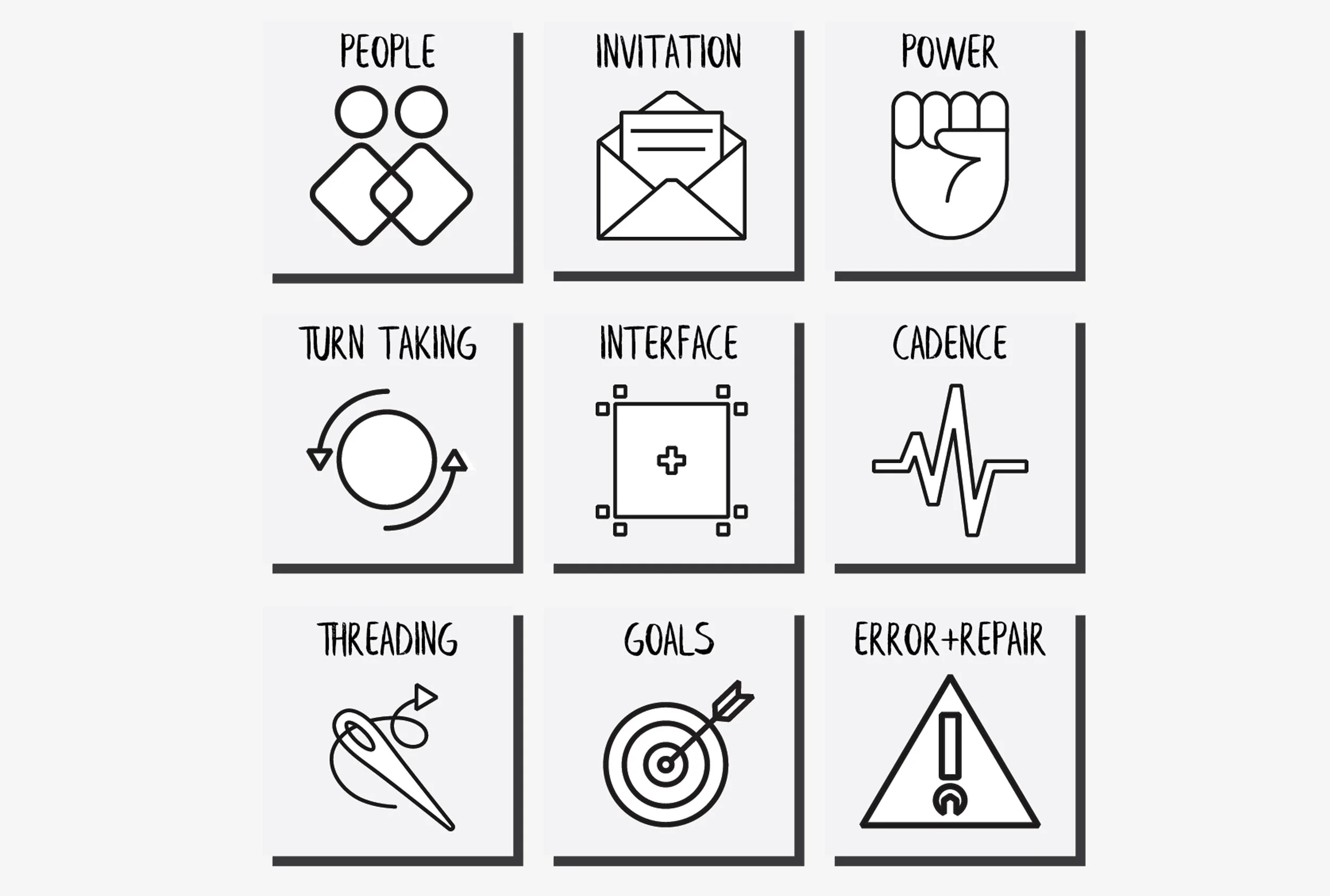Exploring the Conversation OS Canvas
Meetings are Group Conversations
My work over the past several years has been in learning and applying the principles of conversation dynamics, found in studying one-to-one conversations to complex group conversations. You might call these group conversations by another name: meetings or workshops, teamwork…even cultures and communities can be understood through this lens.
The size of the conversations (in number of participants) is different, but the essential structures are the same.
Conversations have Structure
Understanding the patterns behind things is an intellectual pleasure. But there’s practical value, too. If we know the principles on which something is built, we can build it better, or adapt those principles to other contexts. Biomimicry, for example, works to learn how nature makes amazing materials, and how to apply those insights. Learning how geckos stick to walls led to the development of new types of adhesives. Studying insect flight improves miniature drone flight.
Conversations can seem like mushy, fluid things. Holding and guiding a conversation can feel like trying to mail someone a thought. Yet conversations do have a structure, if you slow them down and look closely enough. Mastering that structure can help you design conversations that really matter.
These principles apply to any iterative communication, verbal or visual, over text messages, semaphore code (with flags), or even body language. The rules and patterns of the game are still the same.
….
Learn more about these ideas in my book Good Talk: How To Design Conversations That Matter. You can download a few free chapters here and find links to buy the audio book and physical books online.
….
Conversations Have an Operating System
In my conversation design workshops, I ask, “What are conversations made of?” The answers are diverse: Voices. Ideas. Vibes. Connections. Collaboration. Listening. Emotions. Reactions. Gaps. Openness.
Designing conversations well requires seeing the parts they are made of. From all the models of conversations I’ve worked with, I’ve selected nine core components. I’ve chosen these because they are the easiest to see, the easiest to shift, and they can have the biggest impact. Although vibes and emotions are important in conversations, they’re difficult to hold onto and change.
One way to think about these components is as a fundamental conversation operating system (OS). An OS is the most basic software that allows a device to run other programs — to manage inputs and outputs with the larger world. Technology and people run on code. For technology, the code is zeros and ones. For people, our conversation OS is how we manage and combine these nine fundamental elements, our unique arrangement of habits, rules, and beliefs. We all live by a code, whether we know it or not.
The Conversation OS Canvas
Nine ways of looking at a Conversation
Each of the nine elements of the Conversation OS, can be seen as a question, a way of looking at a conversation from all angles. As a facilitator and leader, mastering and shifting these elements is your job, based on your intentions and vision. I’ve used the OS Canvas to map the current or future desired state of conversations of all shapes and sizes. Below is a quick outline of the 9 elements and how they apply to facilitation and leadership.
…
While this is an excerpt of my recent book: Good Talk: How To Design Conversations That Matter, you can download a few free chapters here and find links to buy the audio book and physical books online.
…
Goals: Why do people join the conversation? What’s the shared goal?
As a leader and facilitator, how do you clarify and intensify the goals of each person and of the group as a whole?
Invitation: How do people get invited in?
As a leader and facilitator, how do you inspire and motivate people to join the conversation?
Turn-Taking: Who speaks and when?
As a leader and facilitator, how do you make sure all voices are heard and matter? What patterns to you have in your toolbox to keep the conversation fresh and fluid?
Error and Repair: How do we know when a mistake has been made? How do we fix it?
As a leader and facilitator, how do you make sure the team feels safe to fail and knows how to repair breaches in trust?
Threading: What is the narrative thread that holds the conversation together? Who weaves it?
As a leader and facilitator, how do you craft the narrative of work? More on that here.
Interface: Where does the conversation happen? What spaces and places (physical and digital) support it?
As a leader and facilitator, do you shape the space to suit the conversation? What elements of space can you see and shape? More on that here.
Cadence: What is the pacing of interactions?
As a leader and facilitator, can you sprint as well as slow down and deepen the conversation?
People: Who do we want to be part of the conversation? Who is not part of the conversation?
As a leader and facilitator, how do you ensure that conversations are diverse and inclusive? How do you bring voices into the conversation?
Power: How is power distributed? Who can change the conversation and how?
As a leader and facilitator, can you distribute power (ie, empower others) as well as take control in a safe and secure way?
…
To go deeper into expanding and exploring your approaches as a facilitator and leader, check out my free online course here.
This essay is an excerpt of my recent book: Good Talk: How To Design Conversations That Matter. You can download a few free chapters here and find links to buy the audio book and physical books online.


